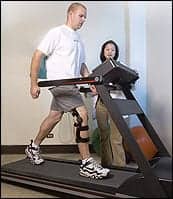
Education is an essential element for developing a following of loyal patients and referrers for an on-site therapy pool. It can be helpful to offer information to other providers such as general physicians and surgeons who are likely to refer individuals to the facility.
by Diana Perez, DPT
Only previously available at elite medical facilities, on-site therapy pools have enjoyed a continuous resurgence for almost 2 decades. Today, it is not uncommon for private physical therapy practices, clinics, universities, athletic performance centers, and sports teams to have at least one therapy pool at their disposal. Gone are the days when a physical therapist’s only choice for aquatic therapy was to head to the nearest public pool and hope to get some space.
Understanding the Differences Between Private and Public Pools
Although both therapy pools and public pools have the same bare bones—a large vessel filled with water—other resemblances end quickly. In fact, on-site advanced therapy pools of the warm-water variety with underwater treadmills are notably advantageous for physical therapists, administrators, and patients—beginning with how an individual enters the pool itself.
It can be difficult for many populations to get into public pools, even if they have access to ladders. For example, those who use a wheelchair or have limited mobility due to physical conditions may not be able to safely or confidently immerse themselves into the water. Private therapy pools, on the other hand, are more likely to have more comfortable and safe entry options. Some pools have ADA-approved pool lifts installed. Among the available options for these lifts are those that are powered by water pressure rather than electricity. Some manufacturers offer ADA-approved pool lifts designed with side seats and manual turn handles that allow them to be used unassisted. The market offers models designed to provide access to above-ground or in-ground pools.
With some pools, such as the one installed at Saluda Nursing Center, Saluda, SC, a variable-depth treadmill floor raises up to meet patients as they walk or are wheeled onto the pool floor. The floor then slowly lowers back to an appropriate water level, such as knee-deep, waist-deep, or sternum level. A waterproof wheelchair is also available from at least one manufacturer that can be immersed as the floor is lowered.
In addition, therapy pools located within a facility are convenient for older patients who need improved conditioning training, but require tremendous stabilization as well. At this skilled nursing facility with a rehab center, the therapy pool includes removable handrails that provide peace of mind for patients affected by balance challenges. It is a wonderful way to increase compliance and set the stage for significant outcomes. Plus, it is filled with warm water, making it an easy sell to those not interested in the cooler temperatures of a public pool.
Competitive Differentiator
With so many benefits, it is not surprising that facilities that have private therapy pools are among the most competitive in their markets. Saluda Nursing Center is located in a small area, but in the first 12 months of having an advanced therapy pool on-site, the facility has gotten referrals from places an hour away. Word travels quickly within communities and among referrers. Thus, the facility’s reputation has begun to build.
However, the best aquatic therapy pool cannot hope to pay for itself on reputation alone. It takes a team of devoted experts willing to think outside the proverbial box. A facility can tout any aquatic therapy pool’s benefits, but they mean nothing without a little innovation. The real secret is for facilities to capture opportunities to generate new revenue streams through creative aquatic therapy pool practices. Doing so can mean the difference between having stellar years and struggling to fill appointments.
Creativity and innovation are absolutely changing the aquatic and physical therapy world, bringing technology deeply into the realm of medicine and science. Emerging therapy pool accoutrements such as underwater treadmill floors, variable-depth floors, high-powered resistance jets, and underwater real-time video capabilities are changing the aquatic therapy pool landscape—much to the delight of therapy professionals and their rehab clients.
The decision for Saluda Nursing Center to take the deep dive into aquatic therapy was powered by a strong belief in the power of creativity. Following are five tips that can be used to boost creative use of a private therapy pool, from marketing to session implementation. Please note that each suggestion can be tweaked to accommodate staffing abilities, organizational mission, and overall goals.
Creative Tip #1: Use Visual Feedback
Regardless of whether a therapist is working with a pediatric or geriatric patient, every individual loves to see real-time progress. In an advanced therapy pool equipped with an underwater camera that syncs to a video screen along the side of the pool, patients and physical therapists can get a better understanding of what is happening beneath the distorted watery view, whether walking on the underwater treadmill or performing step-ups on a step designed for underwater use.
Therapists at this facility have used real-time visual feedback to improve patient gait, reducing problems that could translate to land-based issues. As an example, many clients tend to walk differently on a static pool floor, stepping with their toes. A private therapy pool equipped with underwater treadmill forces them into a more land-based posture with heel-toe stepping. Using video feedback, a physical therapist can make sure that a patient is using motions that will be applicable for land striding.
Creative Tip #2: Consider Group Exercises/Sessions
It is easy to understand why so many organizations balk at the idea of offering group exercises or sessions to the public, or to those who have graduated from their aquatic therapy programs. Yet it can be a financial boon because it offers the chance to utilize a private therapy pool when it might otherwise sit unattended.
Opening the door to group sessions can be financially advantageous, as many people are willing to pay out of pocket to continue receiving the benefits of aquatic therapy in a warm-water, buoyant environment once their physical therapy sessions have ended. Additionally, it is a good way to help patients stay on track with their physical therapy and overall health goals by promoting an atmosphere that is social and may facilitate friendly competition.
Creative Tip #3: Educate Patients and Referrers About Therapy
Education is an essential element for developing a following of loyal patients and referrers for an on-site therapy pool. Begin by offering information to other providers such as general physicians and surgeons who are likely to refer individuals to the facility. Many are open to aquatic therapy and understand the benefits it can provide their patients. Others may not, however, and will need to be shown how helpful it can be. This population does well with statistical data, so the more scientific evidence that is provided in favor of aquatic therapy, the better. It may also be wise to give them adequate documentation about the aquatic therapy codes you frequently use.
Patients should also be educated about the benefits of aquatics as part of the physical therapy process. Although many therapists may tend to assume all patients will love aquatic therapy, that simply is not the case. Sometimes, patients may feel timid about getting dressed in a bathing suit, or are afraid of the water. In these cases, helping those individuals overcome their fears, such as worrying about being off-balance or going underwater, can be allayed with information.
Creative Tip #4: Be Clever with Pool Exercises
Despite wanting to believe that pool exercises are always exciting, the truth is, sometimes they are not. What works for one patient may not be as enticing to another. That is where a boost of innovation comes into play.
To make sessions interesting and beneficial, consider purchasing pool paraphernalia. Hand paddles, kickboards, and balance rings are excellent choices. Other items include volleyballs, footballs, and pool noodles. Ankle and wrist weights, as well as dumbbells designed especially to stand up to a water environment, can add a level of challenge. Surround floats and flotation devices designed to assist with water walking may also offer utility and safety for pool-based activities.
If the therapy pool has a treadmill and/or resistance jets, these tools can make even a seemingly ordinary exercise like catching and throwing a volleyball more difficult—and even fun.
Be sure to incorporate occupational therapy techniques in the pool environment, too. There is nothing wrong with asking a patient to put on pants (over existing shorts or a swimsuit) while in the water. It is a challenge that requires the patient’s full focus, and has definite crossover to land.
As the “drill sergeant” at Saluda, I am known for having a very direct style of incorporating creative play and exercise into aquatic therapy pool appointments or with patients with a military background. I will even chant military cadences to motivate and provide familiarity.
Creative Tip #5: Tell People About the Pool
As difficult as it may be to believe, many facilities keep their therapy pools a guarded secret. Rather than hide the fact that a facility has a top-line therapy pool at its disposal, the facility should, instead, devote a significant marketing effort to raising awareness about it. The more people who know about this competitive advantage, the higher the probability that patients will ask for your physical therapy clinic by name when their physicians recommend presurgery, postsurgery, and/or injury rehabilitation.
There are several ways to get the word out about an aquatic therapy pool. First, one can simply begin with showing off the pool, making it a centerpiece. Because our facility is part of a larger retirement and senior living community, we make certain to showcase the pool for all visitors thinking about becoming part of our family. It shows potential residents and their families that we care about their treatment and recovery. Likewise, it does not hurt to let them know that if they need advanced therapy, they can get it on-site.
Take Your Creativity and Run with It
One of the goals of this article is to spark a natural curiosity and creativity by presenting methods of innovation which, at this facility, have proven to be powerful income generators. For therapists and facility managers, the overarching objective should always be to use the therapy pool to help the facility’s target populations. By adding creative solutions, resources, and ideas to the mix, the chances of having a robust facility with a top-notch reputation for leading-edge care is significantly improved. RM
Diana Perez, DPT, earned a bachelor of science in physical therapy in 1993 from Universidad Nacional de Colombia, and a doctor of physical
therapy from Boston University in 2007. She has worked at Saluda Nursing Center, Saluda, SC, since 2016. For more information, contact [email protected].






Hello, Levi,
I’m pleased that this information is useful to you. Resistance jets are becoming a popular feature because of the creativity with which they can be applied to improve clinical outcomes. There are several manufactures who build pools and offer pool accessories for the physical therapy market. Check out our Buyer’s Guide to see them.
It’s great that you mentioned that ordinary activities could be even more fun and exciting with resistant jets on your pool. My sister and I are thinking of opening a physical therapy clinic in town. With what you’ve said, I’ll try to talk to her about adding aque therapy resistance jets of the small pool we’ll build for the facility. Thanks!